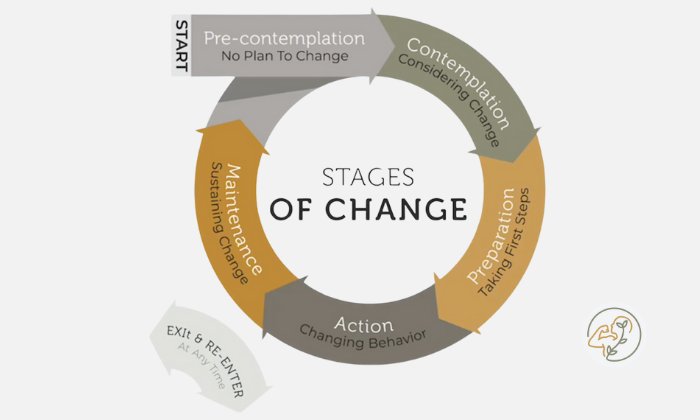Understanding Behavior Change: Help Clients Make Long-Term Change
Mar 14, 2025
If you've been a fitness coach for a while, you've probably talked to many clients who have struggled with yo-yo dieting, and you may even feel frustrated when you see a coaching application come through from a client you helped out a year ago saying they are right back where they started.
The reason that so many people yo-yo diet and go to coach after coach is because they are focused on dieting and losing fat rather than adopting healthy behaviors that will lead to lasting change.
Sometimes, the lack of behavior change is because the clients have never received the right tools for behavior change (especially if they've been trying to do this on their own all these years). Other times, it's because the clients weren't ready to change their behaviors.
In this post, I will share with you the stages of behavior change according to the transtheoretical model so you can help clients go from thinking about changes to actually changing.
Table of Contents
Why Coaches Need to Understand Behavior Change Theory
Stages of Behavior Change
Phase 1: Pre-contemplation
Phase 2: Contemplation
Phase 3: Preparation
Phase 4: Action
Phase 5: Maintenance
Guiding Clients to Their Desired Behavior
Increase the Good Reasons for Change
Decrease Reasons to Stay the Same
Self-Liberation and Commitment
Self-Evaluation
Increasing Self-Belief
More Ways to Create Behavior Change
Behavior Change Strategy
Connect with us!

Why Coaches Need to Understand Behavior Change Theory
Effective fitness coaching is no longer about just providing workout plans and macro recommendations. Clients who hire a fitness coach expect to work with someone who can help them improve their mindset and behaviors to create lasting change.
Knowing behavior change theory allows coaches to understand where clients are in their journey, from contemplating behavior change to figuring out how to maintain their new healthy behaviors.
Without understanding the stages of change, coaches risk pushing their clients too fast or not offering the right support.
However, coaches can improve client adherence, confidence, and long-term success by understanding where their clients are at and giving them custom strategies based on each stage of behavior change.
Years of behavior change research have given us the transtheoretical model, which is broken down into five stages of behavior change. This model is one of the many tools I teach inside the Health Mindset Coaching Certification.
Stages of Behavior Change
An important note about the stages of behavior change: Change is not linear, and individual people will need individual things and will act differently depending on what stage of the behavior change cycle they're at.
While the stages of behavior change are presented in a cycle, you should be aware that people can enter and exit this cycle at any stage of their journey. They can also go backward. All of this is normal.

Phase 1: Pre-contemplation
The pre-contemplation phase is when people have no recognition of a problem behavior or no desire to change.
They are not necessarily happy with where they are at health-wise, but in this stage, they likely think they don't have a problem.
You probably won't see clients in the pre-contemplation stage because they aren't even applying to work with you. You may, however, notice that people in your personal life (maybe family or friends) are at this stage.
Phase 2: Contemplation
People in the contemplation phase are starting to think about change. They aren't necessarily doing anything to change behavior, but they are aware that something needs to change to improve their physical health.
These might be people who have reached out to you or inquired about your services but haven't taken any initiative.
They may like and comment on your social media posts or even talk to you in the DMs. People in the contemplation phase may have even applied for coaching with you but haven't actually committed.

Phase 3: Preparation
The preparation phase is when people really start to pan for change.
People in this phase include your clients who have signed up, and this may be the first time they've ever really focused on their health and fitness.
Something you will likely come across in this stage is your clients wondering if they are cut out for adopting positive health-related behaviors. Your support and guidance will be crucial during this stage if they will ever create true behavior change.
Phase 4: Action
Next, we have the action phase of behavior change.
People at this point in the behavior change journey are out there changing their behaviors. Or, they are at least attempting to make changes.
They might ask for behavior change interventions or say they are ready and need guidance.
These are also people who have been trying to improve on unhealthy behavior but maybe haven't been successful, and that's why they came to you. They likely have behavior change goals and some sense of understanding regarding the changes they need to make to improve their health.
These clients are trying to adopt new behaviors, such as increasing their physical activity or adopting healthy eating habits.
Phase 5: Maintenance
People at this stage in the behavior change process are working on solidifying these new behaviors. There is some risk of relapse or moving backward, but they are likely trying to make these desirable behaviors part of their identity at this point.
So, at this point, the client has an idea of the kind of health behaviors they have to maintain to lose weight and maintain their fat loss or whatever positive behaviors they have to sustain to achieve their desired health outcomes.
They might start asking themselves if this behavior change is worth it and if it's something they really want to do.
This phase is also where a lot of people who are following a fad diet or quick fix will leave the stages of change altogether. They realize that the particular behavior they have been following isn't something they can maintain in the long term. It's not worth it to them to cut out entire food groups, restrict their calorie intake to 1,000 calories a day, or do a high-intensity circuit class five or six days a week.
Their approach starts to feel unrealistic and sustainable.
Your role is extremely important in this stage of their journey because you get to show them how to create healthy behaviors sustainably and in a way that doesn't necessarily have them asking themselves if these behavior changes are worth it.
You get to help your clients feel good about sustaining their positive behaviors and staying within this maintenance phase for a long time.

Guiding Clients to Their Desired Behavior
If you're a good coach, you can help a client make meaningful progress regardless of which stage they come to you in. You can guide them through each stage to get to the next while understanding it's normal for people to spend more time in some stages than others.
You, as the coach in this relationship, can do several things to help guide your clients through each stage and create their desired behavior change.
Increase the Good Reasons for Change
It's important to get clients to identify reasons why behavior change is a good thing and something they want to pursue.
You want to help them identify good reasons to change.
You can ask them to tell you or write out the pros of making the behavior change they are considering.
While it's important that they change because it's something they desire rather than doing it because of pressure from someone else (see this post about intrinsic vs. extrinsic motivation), you can also point out how the behavior change could benefit them or the people around them.
For example, a parent may want to improve their overall well-being because they know it will give them more energy to play with their children and be a good role model for them.
Another way to help clients find reasons to make a behavior change is to have them list how the change could benefit them. Encourage them to think about how the change can benefit them socially, mentally, physically, financially, etc.
Decrease Reasons to Stay the Same
Along with helping your client identify why it's a good reason to change, it's a good idea to discuss why they might not want to stay the same. Uncover those reasons that made them desire behavior change.
You can ask them what the cons are if things were to stay "status quo." Have them consider any negative consequences of staying the same, but also ask them about the benefits of staying the same.
While it may seem counterintuitive to ask clients to identify reasons why it's helpful to stay the same, this method works because it often leads to them saying something like, "Well, I go to the drive-thru several times a week because it's faster and more convenient, which gives me more time with my family, but I know that it would be better if I cooked meals at home. When I think about it, I could probably even turn meal prep into a family bonding activity."
With that method, your client is in the driver's seat and they get to identify the benefit of adopting a desirable behavior while acknowledging why an undesirable behavior is currently working for them.
Also, get them to share how their life would be better if they were to make this change. They might say things like they know their sleep quality and energy levels would improve, which is something you can lean into as they have just identified their personal values.
Another question to ask is whether some discomfort now is worth it to experience the benefits of this change.
Self-Liberation and Commitment
Behavior change requires commitment, and one great way to increase commitment and motivation is to have your client share their goals with others. Ideally, this will look like identifying like-minded people in your client's life, or at least those who support them and their decision to change.
Friends, family, coworkers, and other members of their community are all great examples of people who might be part of their support system on their journey to improve their well-being.
Self-Evaluation
Getting your clients to self-evaluate is a great way to give them autonomy and help them recognize how behavioral change can get them to where they truly want to be.
Have them reflect on their self-image with and without a healthy habit you're talking about implementing. Get them to consider how their self-image is now compared to what it might look like when that habit becomes a part of who they are.
You can also get them to identify their personal values and assess whether their actions uphold those values.
If they say they value a healthy relationship with food but consistently label foods as good or bad and follow strict food rules, their actions don't align with their values. You can have a discussion about why this may be happening, and you'll know you need to help them shift their mindset around food.
Another way to get your clients to self-evaluate is to ask them who they look up to. There are probably habits this person has that your client admires and may want to adopt themselves.
It's a good idea to ask what images come to mind when thinking about the person they want to be. Maybe they envision someone who meal preps instead of going to the drive-thru several nights a week, or they imagine themselves getting out of bed as soon as their alarm goes off in the morning rather than hitting snooze three times before dragging themselves out of bed.
Understanding what their ideal self looks and acts like will help them identify how their current behavior aligns or misaligns with who they want to be.
Increasing Self-Belief
Increasing self-belief or self-efficacy will help your clients realize they can change and don't have to stick to this old behavior forever.
You can ask them to share an example of past times they've set a goal and achieved it.
Maybe the client previously lost the weight they are trying to lose again, which proves they can lose weight, but maybe the methods they tried in the past weren't sustainable enough and didn't create actual behavior change, which is why they ended up where they are now.
They can also identify qualities they already possess that will help them create these behavior changes. If they are a really good cook, they can leverage that to make healthy meals delicious and something they look forward to at mealtimes.

More Ways to Create Behavior Change
Understanding the behavior change science will help you take your clients out of the yo-yo dieting cycle. You have to meet your clients where they are at and provide them with individualized solutions to help them get to where they want to be.
I teach a variety of behavior change frameworks in the Health Mindset Coaching Certification that will allow you to approach each client's situation effectively and in a way that considers your client's current lifestyle and circumstances to create a behavior change strategy that leads to lasting results.
If you're interested in learning how to help your client adopt healthy behaviors that they will stick to, you should check out the Health Mindset Coaching Certification.
It's your opportunity to learn how to help your clients tackle all-or-nothing thinking, overcome self-sabotage, develop self-control, and increase motivation and follow-through (meaning no more getting ghosted on check-in day).
This 13-week program will help you develop the skills to effectively help your clients stick to the plan, stick with you, and achieve long-term success in their health and fitness goals.
Join the waitlist here, and you'll get immediate access to some free primer materials to get you started!
Behavior Change Strategy
Want to learn more about behavior change interventions? Check out this episode of my podcast, Not Another Mindset Show, where I talk about the EAST framework, which is a simple framework that can help your clients shift their mindsets and want to change behavior patterns.
Connect with us!
Email: [email protected]





